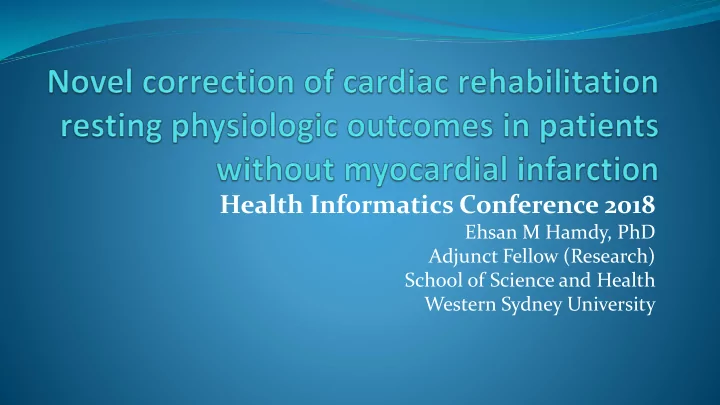

Health Informatics Conference 2018 Ehsan M Hamdy, PhD Adjunct Fellow (Research) School of Science and Health Western Sydney University
It began with... Started 11 years ago in 2007, during my Bachelor I ludicrously announced Prof Lexin Wang that I had observed cardiac rehabilitation, it was all wrong, and I could fix it if he supported my Honours as Supervisor for 2009 I had actually observed patients suffer severe reactions to exercise, inappropriately prescribed by nursing staff In my defence, I wasn’t the only insane science geek emerging that year...
What happened next was weird... He didn’t throw me out: “I believe you”, he said My mind... blown! Went on to my PhD, with Prof Wang as Supervisor then too The first part of that huge project addressed a series of 12 retrospective data reviews We’ll consider the first of these today
Intervention & Patients Cardiac rehabilitation at Westmead hospital in Sydney Between the years 2000 to 2011 Program: High-intensity aerobic interval training Patients: Following some kind of serious cardiac event (4,202 total) We reviewed 1,703 patients who didn’t have a myocardial infarction (“heart attack”) in this particular review
Outcomes & Corrections Total of 1,073 patients without MI completed the program Majority were males (N = 814, 75.86%), which was the first important finding (confirmed earlier results elsewhere) This study reviewed resting values for: heart rate (HR) systolic blood pressure (SBP) diastolic blood pressure (DBP).
Outcomes & Corrections Records were grouped into SB subgroups based on their measured blood pressure at pre-program assessment: SB1 – resting SBP below 100 mmHg SB2 – resting SBP between 100 to 130 mmHg SB3 – resting SBP greater than 130 mmHg Note: this is different to a pre-program diagnosis of hypertension by referring cardiologist
Outcomes & Corrections SB subgroups were further divided into comorbidity subgroups (in males only, insufficient female numbers) Based on the number of conditions including hypertension, hypercholesterolemia, diabetes and overweight/obesity: MC0 – no conditions MC1 – one condition MC2 – two conditions MC3 – three conditions MC4 – four conditions
Outcomes & Corrections Table 1 – Resting physiologic outcomes in males and females SB1 SB2 SB3 Total (n) 113 515 186 ∆(bpm) -1.3 -1.4* -0.4 HR SD 12.1 12.3 11.3 ∆(mmHg) Males 10.6* 1.6* -12.0* SBP # SD 17.1 14.4 18.7 ∆(mmHg) 4.7* 0.1 -4.3* DBP # SD 11.0 9.8 10.0 Total (n) 33 147 79 ∆(bpm) -2.6 -2.6* -1.2 HR SD 12.4 14.5 13.1 ∆(mmHg) Females 11.3* -1.0 -12.0* SBP # SD 10.4 20.5 15.5 ∆(mmHg) 8.8* -2.0* -4.6* DBP # SD 10.8 10.9 9.5
Novel Trends First, it’s not accurate to simply state that “exercise reduces blood pressure”, but rather exercise actually “CORRECTS” blood pressure Those with low BP (hypotensives) achieve increases Patients with high BP (hypertensives) show reduced BP Second, comorbidities significantly impact resting physiology Hypotensives with HIGHER MC comorbidity may show greater outcomes Hypertensives with LOWER MC comorbidity may achieve greater changes
Implications: Clinical & Informatics No longer acceptable to look at outcomes “in bulk” Factors which influence outcomes should be effectively corrected for during analysis Most importantly, we need to start classifying CR patients appropriately, in order to prescribe exercise safely and more effectively
Other parts of the project There were 11 other retrospective reviews Clinical CR program including novel elements based on the principles of exercise science Patient classification Patient motivation and education Exercise assessment and prescription But the most important novel element was...
First use of “physiologic efficiency” Framework of novel algorithms “Physiologic algorithms of physical exertion” (PAPE) Physiologic efficiency (equivalent of miles-to-the-gallon) This concept of physiologic efficiency was developed and applied here for the first time in any context PAPE was extended in follow-up patents for new IP work (ongoing) Exhaustion, first- and second-order adaptation Also includes “ mechano- physiologic” aspects of all the above
Follow-up Full discussion and references in the linked paper Discussion of extended PAPE framework in tomorrow’s poster session Presenting at Health Data Analytics 2018 Full coverage of the extended PAPE framework and IP development Melbourne – October 22 nd to 23 rd Thank you for your time. More info: ehsan@moovpad.com
Recommend
More recommend